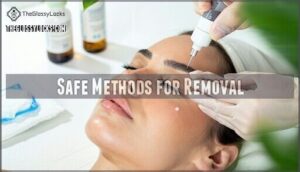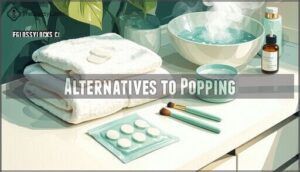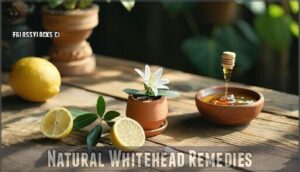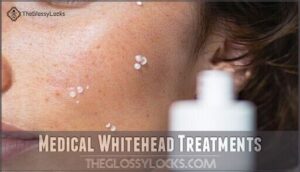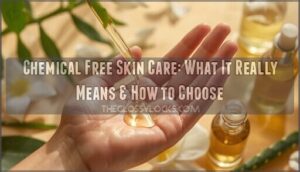This site is supported by our readers. We may earn a commission, at no cost to you, if you purchase through links.

Salicylic acid treatments effectively dissolve the buildup causing these closed comedones, while retinol accelerates cell turnover to prevent future blockages.
For stubborn whiteheads, professional extraction by a dermatologist guarantees safe removal without scarring.
Whitehead patches offer a gentler overnight solution by drawing out impurities, and it’s crucial to avoid popping them yourself, as this can lead to infection and permanent scarring.
Consistent use of non-comedogenic moisturizers and broad-spectrum sunscreen helps maintain clear skin by preventing inflammation and excess oil production that triggers whitehead formation.
Table Of Contents
- Key Takeaways
- What Are Whiteheads
- Getting Rid of Whiteheads
- Whitehead Prevention Tips
- Safe Whitehead Removal
- Natural Whitehead Remedies
- Medical Whitehead Treatments
- Maintaining Clear Skin
- Frequently Asked Questions (FAQs)
- How do I remove whiteheads on my face?
- How to get rid of whiteheads in 5 minutes?
- How can I remove whiteheads from my face?
- Why am I getting so many whiteheads?
- Should you pop whiteheads?
- Is it good to squeeze out whiteheads?
- How long do whiteheads typically last?
- Can whiteheads spread to other areas of the body?
- Do whiteheads leave scars after they heal?
- What is the difference between whiteheads and milia?
- Conclusion
Key Takeaways
- Use gentle daily cleansing with salicylic acid – You’ll dissolve the oil and dead skin buildup that’s clogging your pores without stripping your skin’s natural barrier.
- Never pop whiteheads yourself – You’ll risk permanent scarring and infection, so opt for professional extraction by a dermatologist or use whitehead patches instead.
- Start retinol gradually for prevention – You’ll accelerate cell turnover to prevent future blockages, beginning with 0.25% strength twice weekly to avoid irritation.
- Stick with consistent non-comedogenic products – You’ll need oil-free moisturizers and broad-spectrum sunscreen daily to maintain clear skin without triggering new breakouts.
What Are Whiteheads
Whiteheads are closed comedones that form when dead skin cells, oil, and bacteria clog your pores completely, creating small white or flesh-colored bumps beneath the skin’s surface.
Unlike blackheads, these blemishes remain sealed under a thin layer of skin, which prevents the contents from oxidizing and turning dark.
Definition and Characteristics
Whiteheads are closed comedones that form when pores become completely blocked with sebum, dead skin cells, and bacteria.
Unlike blackheads, these non-inflammatory acne bumps appear as small, flesh-colored or white raised spots because they’re sealed beneath the skin’s surface.
You’ll typically find them on your face, chest, and back where oil production runs high.
Causes and Triggers
Several factors create the perfect storm for whitehead formation.
Hormonal fluctuations during puberty, menstruation, and pregnancy boost oil production, while genetic predisposition determines your skin’s tendency toward breakouts.
Skincare ingredients like coconut oil and heavy makeup can cause pore-clogging, trapping sebum and dead skin cells.
Environmental factors including pollution and stress also trigger excess oil production, creating ideal conditions for whiteheads to develop, influenced by overall skin’s tendency.
Symptoms and Signs
Spotting whiteheads isn’t rocket science—these visible bumps appear as small, flesh-colored or white raised dots on your skin.
You’ll notice changes in skin texture, particularly in affected areas like your nose, cheeks, and chin, where pores become clogged with oil and dead cells, sometimes causing mild redness without significant skin inflammation, which can be described as mild redness and involve clogged pores.
Getting Rid of Whiteheads
Tackling stubborn whiteheads requires a strategic approach that goes beyond basic skincare. Professional extraction by a dermatologist offers the safest whitehead removal method, using sterile tools to prevent scarring and infection.
Whitehead patches provide a gentler alternative, drawing out impurities overnight without manual manipulation. For persistent cases, chemical peels containing salicylic acid effectively dissolve the buildup causing clogged pores.
Laser treatment targets deeper congestion while promoting skin renewal. When topical solutions aren’t enough, oral medications like antibiotics or hormonal treatments address underlying causes. One should also consider that excess oil production can exacerbate the issue.
The key to successful whitehead treatment lies in choosing methods that match your skin’s sensitivity level. Remember, patience is vital—aggressive whitehead extraction often backfires, leading to more breakouts and potential scarring. Combine professional treatments with consistent home care for the best results, ensuring a successful treatment and promoting overall skin health through consistent home care.
Whitehead Prevention Tips
Preventing whiteheads requires consistent habits that keep your pores clear and your skin balanced.
You’ll need to focus on four essential practices: daily cleansing, regular exfoliation, retinol use, and sun protection to stop whiteheads before they form.
Cleanse Daily
Daily cleansing forms your skin’s first line of defense against whitehead formation.
You’ll want to establish a consistent routine that removes excess oil, dirt, and makeup without stripping your skin’s natural barrier.
Your skin’s barrier depends on consistent cleansing to prevent pore-clogging buildup.
Here’s your cleansing roadmap:
- Morning rinse with lukewarm water – keeps natural oils intact while removing overnight buildup
- Evening gentle cleanser application – dissolves makeup, sunscreen, and daily pollutants completely
- Double cleansing when wearing makeup – guarantees thorough removal without aggressive scrubbing
Choose mild cleansing products with ceramides or gentle surfactants.
Avoid harsh astringents that trigger oil overproduction.
Your nighttime routine should include thorough facial cleanser use, while morning skin cleansing can be simpler.
Proper cleansing frequency prevents pore congestion without causing irritation.
Exfoliate Regularly
Regular exfoliation removes dead skin cells that trap oil and bacteria in your pores.
Chemical exfoliation using salicylic acid works better than physical scrubs for sensitive skin, preventing irritation while clearing congested pores. You can find a salicylic acid exfoliant online.
Exfoliate 2-3 times weekly – overdoing it triggers more oil production. Post-exfoliation care includes gentle moisturizing to maintain your skin’s protective barrier and prevent dryness-induced breakouts, ensuring proper skin care and gentle moisturizing.
Introduce Retinol
Retinol becomes your skin’s best friend when you’re ready to tackle stubborn whiteheads. This vitamin A derivative accelerates cell turnover, preventing dead skin cells from clogging your pores in the first place.
- Start slow: Begin with 0.25% retinol strength twice weekly to avoid irritation
- Apply at night: Retinoids break down in sunlight, making evening application most effective
- Moisturize after: Combat dryness and flaking by following with a gentle, non-comedogenic moisturizer
- Be patient: Retinol benefits appear after 6-12 weeks of consistent use
Retinol side-effects like redness and peeling are normal initially. If traditional retinol feels too harsh, consider retinol alternatives like retinyl palmitate or bakuchiol for gentler results.
Use SPF
Sun protection is your skin’s best friend when fighting whiteheads.
UV rays worsen acne by increasing inflammation and triggering excess oil production.
Choose a broad-spectrum SPF 30+ facial sunscreen that’s oil-free and non-comedogenic.
Apply generously every morning and reapply every two hours.
Look for zinc oxide or titanium dioxide if you have sensitive skin – they’re gentler than chemical sunscreens.
Safe Whitehead Removal
When you’re tempted to squeeze that whitehead, remember that improper removal can lead to scarring, infection, and more breakouts. Understanding safe extraction methods protects your skin while effectively clearing blemishes.
Risks of Popping Whiteheads
Popping whiteheads might seem tempting, but it’s basically playing Russian roulette with your face.
Your skin doesn’t need a battlefield—gentle treatment wins the war against whiteheads
The consequences can haunt you for months or even years.
Here’s what you’re risking:
- Skin infection – Open wounds invite bacteria like Staphylococcus aureus, potentially causing cellulitis
- Permanent scars – Up to 95% of people who pop develop lasting acne scarring
- Facial damage – Post-inflammatory hyperpigmentation can persist over a year
Popping consequences extend beyond temporary acne irritation, creating deeper acne inflammation that spreads to neighboring pores.
Following a skin care routine is essential to avoid such complications.
Safe Methods for Removal
When professional help isn’t available, sterile extraction becomes your safest option for removing whiteheads. Dermatologist assistance guarantees proper technique, but you can perform safe extractions at home with the right approach.
Here are five essential steps for safe whitehead removal:
- Apply warm compress for 5-10 minutes to soften the whitehead and open pores
- Use sterile extraction tools or clean hands wrapped in tissue – never use fingernails
- Gentle pressure only – press down and outward, stopping if resistance occurs
- Clean immediately with antiseptic to prevent infection and reduce inflammation
- Apply hydrocolloid bandages overnight to draw out remaining debris and promote healing
Professional tools like comedone extractors minimize tissue damage compared to fingernails. It’s vital to source high quality tools for safe use. This method prevents the scarring and infection risks associated with aggressive popping whiteheads while effectively clearing stubborn lesions.
Alternatives to Popping
Instead of squeezing, try warm compresses to encourage natural drainage.
Whitehead patches draw out impurities overnight without damage.
Professional extraction by dermatologists guarantees safe removal.
Topical treatments with salicylic acid dissolve buildup gently.
Gentle exfoliation removes dead skin that traps oil.
These whitehead remedies effectively clear whiteheads without scarring risks that come with popping.
Natural Whitehead Remedies
If you’re looking for gentler alternatives to harsh chemicals, natural remedies can help reduce whiteheads without irritating your skin.
While these methods work more slowly than prescription treatments, they’re often safer for sensitive skin and use ingredients you might already have at home.
Tea Tree Oil
Tea tree oil stands as a proven whitehead warrior, with 5% concentration showing 45% improvement in mild acne within six weeks.
Its star ingredient, terpinen-4-ol, tackles acne-causing bacteria while reducing inflammation by up to 40%.
Apply diluted tea tree oil twice daily for best results, but patch test first since 10-15% of sensitive individuals may experience irritation.
Aloe Vera
Aloe vera gel works wonders for whitehead skin care through its natural healing properties.
This plant speeds up blemish recovery by 35% within seven days while reducing bacteria by 25%.
For aloe application, use fresh gel twice daily on clean skin.
Aloe benefits include non-comedogenic hydration and enhanced absorption of other whitehead home remedies.
Aloe sourcing from fresh plants works best, though quality commercial gels suffice.
Aloe combinations with tea tree oil boost effectiveness.
Minimal aloe side-effects make it suitable for daily use, rarely causing skin irritation, making it a great option for daily use.
Witch Hazel
Witch hazel’s astringent properties make it a powerhouse for tackling whiteheads naturally. This plant extract reduces excess oil by 20% and tightens pores through tannins that prevent blockages from forming in the first place.
- Witch Hazel Benefits: Decreases oil production and calms inflammation in mild to moderate acne cases
- Witch Hazel Extraction: Natural tannins tighten pores and reduce whitehead formation effectively
- Witch Hazel Toners: Alcohol-free versions work best for sensitive skin without causing dryness
- Witch Hazel Alternatives: Consider gentler astringents if you experience irritation or redness
Regular application helps lower inflammation markers while improving recovery time for existing blemishes. The key is choosing alcohol-free witch hazel formulations to avoid stripping your skin’s natural moisture barrier. Natural tannins provide skin toning benefits.
Apply twice daily with a cotton pad, focusing on whitehead-prone areas like your T-zone. This natural remedy works by removing excess sebum while maintaining your skin’s delicate balance, making it an excellent addition to any whitehead-fighting routine.
Lemon Juice
Citric acid in lemon juice naturally exfoliates dead skin cells, reducing whitehead formation by up to 25% monthly.
However, lemon acidity can cause skin irritation and photosensitivity risk. Always dilute lemon juice before application to prevent redness.
Apply diluted lemon juice at night to minimize sun sensitivity. This home remedy offers antibacterial benefits for acne-prone skincare routines.
Medical Whitehead Treatments
When over-the-counter treatments aren’t cutting it, medical options can provide stronger, more targeted solutions for stubborn whiteheads.
These prescription and professional treatments work deeper than home remedies, tackling the root causes with scientifically-proven ingredients.
Retinoid Creams
While natural remedies offer gentle approaches, prescription-strength vitamin A derivatives provide more powerful results. Retinoids work by accelerating cell turnover, preventing pore blockages that create whiteheads.
Many users seek specialized products for this purpose.
Here’s how to maximize retinoid effectiveness:
- Start with lower retinoid strength – Begin with 0.025% tretinoin or over-the-counter retinol
- Apply every third night initially – Gradually increase application frequency to nightly use
- Use pea-sized amounts – More product doesn’t mean faster results, just more irritation
- Layer with moisturizer – Apply retinoids first, then moisturizer for irritation management
- Stick with consistent use – Long-term benefits appear after 12 weeks of regular application
Prescription options like adapalene and tretinoin show up to 70% whitehead reduction within three months. Over-the-counter retinols work more gently but still deliver significant retinol benefits. Start slow – your skin needs time to adjust to increased cell renewal.
Salicylic Acid
Salicylic acid works like a gentle key, opening clogged pores by dissolving the dead skin cells that trap oil beneath the surface.
This beta hydroxy acid penetrates deep into your pores, making it incredibly effective for unclogging pores and preventing new whiteheads from forming.
You’ll find salicylic acid in various skin care products, from cleansers to spot treatments, typically in concentrations ranging from 0.5% to 2%. Start with lower acid concentration products and gradually increase application frequency to avoid side effects like dryness or mild stinging.
For enhanced results, many dermatologists recommend combining salicylic acid with synergistic ingredients like niacinamide, creating a powerful acne treatment that helps exfoliate skin while maintaining moisture balance. To combat potential dryness, consider using hyaluronic acid afterwards for ideal hydration.
Benzoyl Peroxide
Benzoyl peroxide delivers a powerful one-two punch against whiteheads by eliminating bacteria and clearing blocked pores.
Benzoyl peroxide acts as your skin’s personal bouncer—kicking out bacteria while clearing the way for healthier pores
This OTC treatment works best at 2.5-5% concentrations for facial acne products.
Here’s your game plan for effective spot treatment:
- Start low and go slow – Begin with 2.5% strength to minimize side effects like redness or peeling
- Apply sparingly – Use application techniques targeting only affected areas to prevent irritation
- Expect results – Treatment duration typically shows 60% reduction in whiteheads after 4-6 weeks
Product recommendations include combination formulations with adapalene for faster results.
Consulting a Dermatologist
When home remedies and over-the-counter treatments aren’t cutting it, dermatologists offer professional extraction and prescription strength solutions.
Board-certified dermatologists diagnose your specific acne type and create personalized skincare plans. They address scarring concerns while providing expert dermatological care that goes beyond what you can achieve at home.
| When to See a Dermatologist | Treatment Benefits |
|---|---|
| Persistent whiteheads after 12 weeks | Professional extraction with sterile tools |
| Painful, inflamed lesions | Prescription strength retinoids (55-75% success) |
| History of scarring | Chemical peels and laser therapies |
| Sudden severe breakouts | Hormonal medication options |
Dermatologists detect micro-comedones through specialized imaging and perform patch tests to rule out allergic reactions. They may order bloodwork to check for hormonal imbalances contributing to breakouts.
Treatment options include retinoid creams, chemical peels, light therapy, and oral medications when topical treatments prove insufficient. Early intervention reduces scarring risk substantially.
Maintaining Clear Skin
Once you’ve successfully treated your whiteheads, maintaining clear skin requires consistent daily habits and smart product choices.
The key is creating a gentle routine that supports your skin’s natural balance without triggering new breakouts.
Gentle Cleansers
Choosing the right cleanser is your foundation for clear skin.
Gentle cleansers maintain pH balance while removing whiteheads without stripping natural oils or causing irritation.
Key cleanser features for whitehead-prone skin:
- pH-balanced formulas: Keep skin’s natural barrier intact and prevent overproduction of oil
- Ceramide cleansers: Strengthen skin barrier while providing noncomedogenic cleansing power
- Double cleanse method: Oil cleansers first, then water-based cleanser removes stubborn makeup and buildup
Look for cleanser ingredients like niacinamide or salicylic acid.
Many people also look for fragrance-free skincare options to avoid irritation.
Your skincare routine should include gentle cleansers twice daily to get rid of whiteheads effectively.
Moisturizing
Even with oily skin, you need moisture to maintain your skin barrier and prevent overproduction of oil.
Choose noncomedogenic, oil-free products with gentle formulas that won’t clog pores or trigger breakouts.
| Skin Type | Best Moisturizer Features |
|---|---|
| Oily Skin | Lightweight, gel-based, oil-free products |
| Dry Skin | Cream-based formulas with ceramides and hyaluronic acid |
| Sensitive Skin | Fragrance-free, gentle formula with minimal ingredients |
| Combination | Dual approach or balanced lightweight moisturizers |
| Acne-Prone | Noncomedogenic face moisturizers with niacinamide |
Hydration importance can’t be overstated – when your skin lacks moisture, it compensates by producing excess oil, creating more whiteheads.
Look for moisturizers labeled "noncomedogenic" and "oil-free" to guarantee they won’t block pores.
Ingredients like niacinamide help regulate oil production while maintaining proper hydration levels.
Apply moisturizer to slightly damp skin for better absorption and enhanced barrier protection.
Avoiding Heavy Makeup
Why let heavy makeup sabotage your skin-clearing efforts? Choose lightweight formulas and prioritize makeup hygiene for clearer skin:
- Switch to lightweight formulas – Avoid comedogenic products with pore-clogging ingredients like heavy foundations and thick concealers
- Clean makeup brushes weekly – Dirty brushes harbor bacteria that transfer to your face during application
- Practice thorough nighttime removal – Double cleanse to eliminate all makeup residue before bed
Replace expired products regularly and consider minimalist looks that let your skin breathe.
Wearing Sunscreen
Daily SPF isn’t just about preventing wrinkles—it’s your secret weapon against acne flare-ups.
Sun damage triggers inflammation and excess oil production, creating perfect conditions for whiteheads.
Choose oil-free, broad-spectrum sunscreen with nonirritating ingredients that won’t clog pores.
Apply generously every morning, regardless of weather, and your skin will thank you with fewer breakouts and better texture.
Frequently Asked Questions (FAQs)
How do I remove whiteheads on my face?
Think of your skin as a garden—whiteheads are stubborn weeds.
Wash your face gently, use oil-free products, exfoliate with salicylic acid, and keep hands away.
Consistency, patience, and clean habits help these bumps fade.
How to get rid of whiteheads in 5 minutes?
You can’t completely eliminate whiteheads in just five minutes.
Apply a warm compress for three minutes to soften the area, then gently cleanse with salicylic acid cleanser.
This helps but won’t fully clear them instantly.
How can I remove whiteheads from my face?
Sarah struggled with stubborn whiteheads on her chin for months until she discovered gentle exfoliation works better than aggressive picking.
Use salicylic acid cleansers twice daily, apply retinoids nightly, and gently extract ready whiteheads with clean hands.
Avoid harsh scrubbing—it’ll backfire by triggering more oil production.
Consistent care beats quick fixes.
Your skin needs time to heal and respond to treatment.
Oil-free, noncomedogenic products prevent new clogs while existing whiteheads clear naturally.
Professional extraction from a dermatologist offers the safest removal option when DIY methods aren’t cutting it.
Remember: patience pays off when dealing with these closed comedones, and it’s essential to use oil-free and noncomedogenic products.
Why am I getting so many whiteheads?
You’re experiencing frequent whiteheads because your pores are getting clogged with excess oil, dead skin cells, and bacteria.
Hormonal changes, genetics, diet, stress, and using comedogenic skincare products all contribute to this frustrating cycle.
Should you pop whiteheads?
Like squeezing a balloon too hard, popping whiteheads backfires.
You’ll risk scarring, infection, and inflammation.
The broken skin invites bacteria, creating bigger problems.
Instead, let them resolve naturally or use warm compresses to encourage gentle drainage.
Is it good to squeeze out whiteheads?
No, you shouldn’t squeeze whiteheads. Popping them can push bacteria deeper, cause scarring, and lead to inflammation. Instead, use gentle cleansers, salicylic acid, or let them resolve naturally.
How long do whiteheads typically last?
Frustratingly, whiteheads don’t have a universal timeline – they’ll typically last anywhere from a few days to several weeks depending on your skin’s healing process.
Whether you resist the urge to pick at them is also a factor in how long they last, as this can significantly impact the healing process.
Can whiteheads spread to other areas of the body?
Whiteheads don’t literally spread like infections, but you’ll likely develop them in multiple areas where you have hair follicles and oil glands – your face, chest, back, and shoulders.
Do whiteheads leave scars after they heal?
Properly treated whiteheads typically don’t scar, but you’ll risk permanent marks if you pick, squeeze, or pop them.
The deeper damage from improper removal creates lasting indentations and discoloration on your skin.
What is the difference between whiteheads and milia?
These tiny white bumps might look identical, but they’re completely different beasts.
Whiteheads contain oil and dead skin cells that can be extracted, while milia are keratin-filled cysts under skin that resist typical acne treatments and require professional removal, which makes them completely different beasts in terms of treatment.
Conclusion
Before the printing press made skincare wisdom accessible to all, understanding how to get rid of whiteheads required consulting village healers who passed down remedies through generations.
Today, you have proven methods at your fingertips. Consistent cleansing with salicylic acid dissolves pore blockages, while retinoids prevent future breakouts.
Professional extractions handle stubborn cases safely. Natural remedies like tea tree oil complement medical treatments.
Remember, patience and consistency are key—most treatments need 6-8 weeks to show results. Following these evidence-based approaches will clear your skin effectively.
- https://www.mdacne.com/article/danger-of-popping-pimples-the-american-academy-of-dermatology
- https://www.nationalgeographic.com/science/article/triangle-of-death-face-acne
- https://drdavinlim.com/active-acne-acne-scar-revision-the-importance-of-absolute-remission/
- https://my.clevelandclinic.org/health/diseases/21222-acne-scars
- https://www.houstonmethodist.org/blog/articles/2021/jun/will-acne-scars-fade-over-time/



